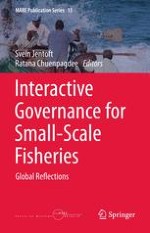2015 | OriginalPaper | Buchkapitel
8. Lessons from Existing Modes of Governance in Malawi’s Small-Scale Fisheries
verfasst von : Mafaniso Hara, Steve Donda, Friday Njaya
Erschienen in: Interactive Governance for Small-Scale Fisheries
Aktivieren Sie unsere intelligente Suche, um passende Fachinhalte oder Patente zu finden.
Wählen Sie Textabschnitte aus um mit Künstlicher Intelligenz passenden Patente zu finden. powered by
Markieren Sie Textabschnitte, um KI-gestützt weitere passende Inhalte zu finden. powered by
